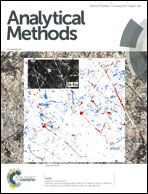A novel ditopic chemosensor for cadmium and fluoride and its possible application as a pH sensor†
Abstract
A urea-based BPC [1,5-bis(perfluorophenyl)carbonohydrazide] molecule with four acidic NH protons has been synthesized by a facile synthetic process. The molecule was found to be a ditopic chemosensor for Cd2+ and F− ions. BPC was synthesized from low-cost starting materials, dinitrophenyl hydrazine and triphosgene. The host–guest interactions between the ions (Cd2+ and F−) were not only confirmed by convenient spectroscopic techniques such as UV-Vis, PL, 1H-NMR, FT-IR, and cyclic voltammetry but also through modern DFT, the results of which were in good agreement with the experimental results. In vitro studies in human cancer cells (HeLa cells) were successfully performed with BPC and Cd2+ using fluorescence microscopy. The reversible UV-Vis response for BPC with F−, OH− and H+ mimics multiple logic functions and can be used for several complex electronic circuits based on logic operations. The pH sensor (BPC) can be further interfaced with suitable circuitry interfaced with appropriate programming for ease of access and enhancement of its practical applications.


 Please wait while we load your content...
Please wait while we load your content...